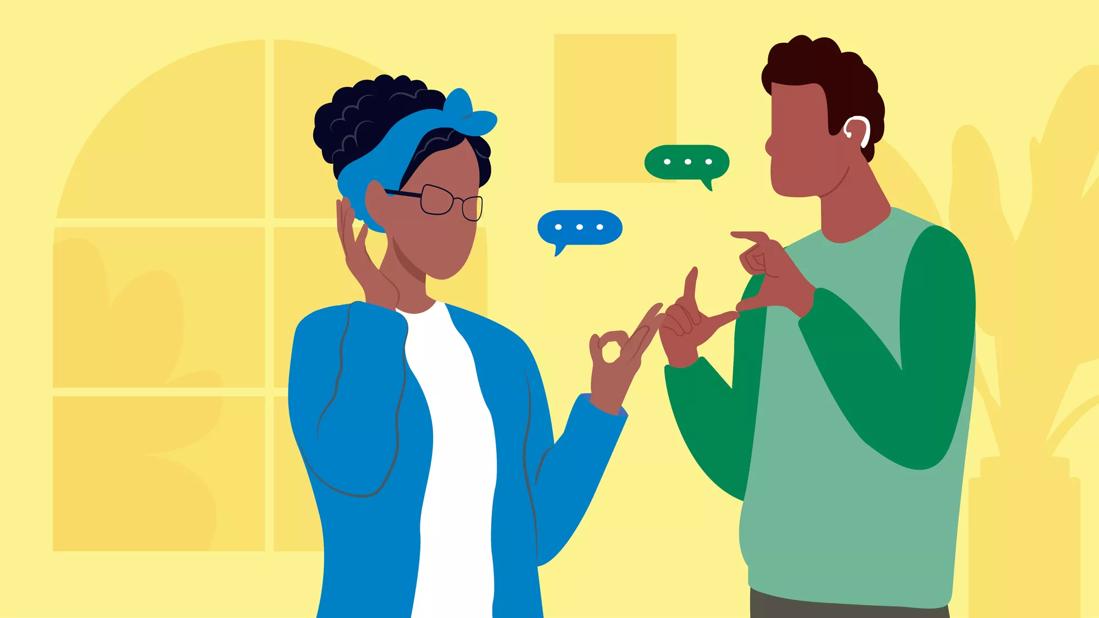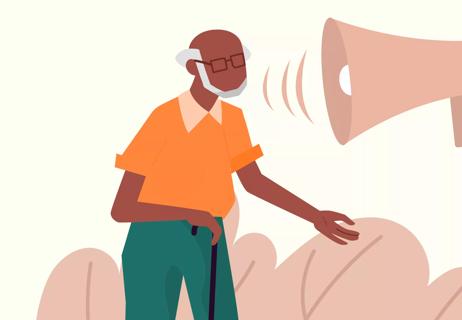Reduce background noise, don’t talk too fast or too slow and above all, ask what’s most helpful to them

When someone you love starts to experience hearing loss, it can take some extra work from all conversation partners to ensure you can keep understanding one another.
Advertisement
Cleveland Clinic is a non-profit academic medical center. Advertising on our site helps support our mission. We do not endorse non-Cleveland Clinic products or services. Policy
“Remember, communication involves at least two individuals: A talker who sends the message, and a listener who receives the message,” says audiologist Sarah Sydlowski, AuD, PhD. “As a member of this communication pair, there are some things you can do to improve the conversation.”
To improve your communication skills when talking with someone who has hearing loss, Dr. Sydlowski advises to:
These tips can be helpful whether or not the person you’re talking to has begun using hearing aids or cochlear implants. Though hearing devices can be life-changing, it can still be difficult to hear in some situations, particularly when there is background noise or in large groups.
Let’s delve deeper into tips for successfully communicating with someone with hearing loss.
All the tips we’re about to discuss are all good general rules for improving your communication skills — with anyone, including people with hearing loss. But in a one-on-one scenario, the best thing you can do is to ask the other person what, if anything, they need from you.
Advertisement
“This indicates that you’re willing to be a partner in maximizing your ability to communicate with one another,” Dr. Sydlowski says.
A person who has hearing loss may not always recognize when you’ve begun speaking to them, so try to first get their attention. Say their name or, if it’s appropriate, lightly touch their arm or shoulder. If you know they hear better from one ear, move to that side before you start talking.
“These simple gestures on your part can help them prepare to listen so they don’t miss the first part of the conversation,” Dr. Sydlowski says.
But don’t clap, wave your hands around in their face or sneak up on them from behind. A good rule of thumb is that if something would be rude to do to a person without hearing loss, you shouldn’t do it to a person with hearing loss either.
Just as a picture is worth a thousand words, your face says almost as much as your words do. If you typically “talk with your hands” or have an expressive face, you don’t need to try to stop for the sake of a person who has hearing loss.
“Your facial expressions and body language add vital information to the messages you’re trying to convey,” Dr. Sydlowski shares. “We can often see a person's excitement, joy, confusion or frustration by watching their facial expressions or body language.”
Many people with hearing loss use some amount of speechreading, which means they watch the face and mouth of the person they’re talking to.
“Speechreading helps to improve speech perception,” Dr. Sydlowski explains. “Many sounds that are hard to hear can more easily be seen. The S sound, for example, is very difficult to hear but is much easier to speechread.”
Help your conversational partner make use of visual cues by keeping your mouth and face visible:
You don’t need to shout when you’re speaking to someone with hearing loss. In fact, shouting actually distorts your words, which can make things more difficult. “Speak distinctly but without exaggeration,” Dr. Sydlowski advises, “and speak at a normal rate, not too fast or too slow.”
You can use intentional pauses in the conversation to give the other person time to process speech. It can also be helpful to specifically note when you’re changing subjects, like by saying, “OK, onto the next topic!”
Finally, try not to mumble or allow your sentences to trail off, as it can be very hard to understand — even for people who don’t have hearing loss.
Advertisement
If the person you’re speaking to has trouble understanding what you’ve said, repeat it once. If they’re still having difficulty, figure out a new way to say it, like by using different words with the same meaning.
“If someone doesn’t understand your words the first time, it’s likely they also won’t understand them a second time,” Dr. Sydlowski says. “Instead, try to rephrase it.”
If you say, for example, “I’m going to the grocery store,” and it’s not understood, repeat it once and then rephrase it or add additional detail: “I’m going to the supermarket to pick up groceries for dinner.”
You can also ask which piece of the conversation they didn’t catch and just repeat that phrase or word. In this example, “grocery store” is what wasn’t understood, so you could just repeat those words: “grocery store.”
The place where you speak can have as much of an impact as the way that you speak. While it’s not always possible to completely change your environment (a busy restaurant is naturally going to be noisy), keep these tips in mind for communicating in social settings:
Advertisement
If you and your conversation partner agree that you could both use an assist, you can download a dictation app like Dragon, Otter or LiveTranscribe. When you speak, your words will show up on the screen, which the other person can then read.
Just because someone is wearing hearing aids doesn’t mean they can hear everything you say — or, conversely, that they have any trouble hearing what you say. Be receptive to their feedback and requests, like if they ask you to move someplace quieter, spit out your gum or slow down your speech.
“Above all, just be thoughtful and empathetic,” Dr. Sydlowski says, “and keep the lines of communication open.”
Advertisement
Learn more about our editorial process.
Advertisement

Sudden hearing loss can have many causes — but it’s important to seek treatment fast

Hearing aids can be enough for some people, but other devices — like for your phone, TV and fire alarm — can help, too

Untreated hearing loss can affect kids’ speech and language development and their overall quality of life

Avoid poorly fitting gear, opt for quality devices and consider sound-limiting technology to help prevent noise-induced hearing loss

COVID-19 may be associated with tinnitus, but research is still ongoing

There are lots of tips, tricks and assistive devices out there that can help

Ringing is already a sign of damage, but you can take steps to keep your hearing protected

Keeping your brain healthy is key

Babies can get congested easily, but you can calm their cough by keeping them hydrated, using nasal drops and running a humidifier

Weight loss may cause loose, sagging skin and muscle loss to your rear

Several conditions, like vitiligo and fungal infection, can cause a loss of pigmentation, leading to white spots or patches on your skin